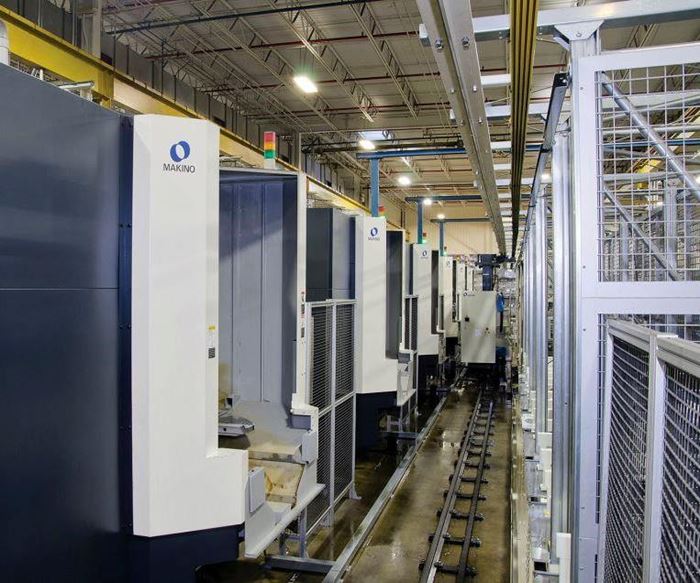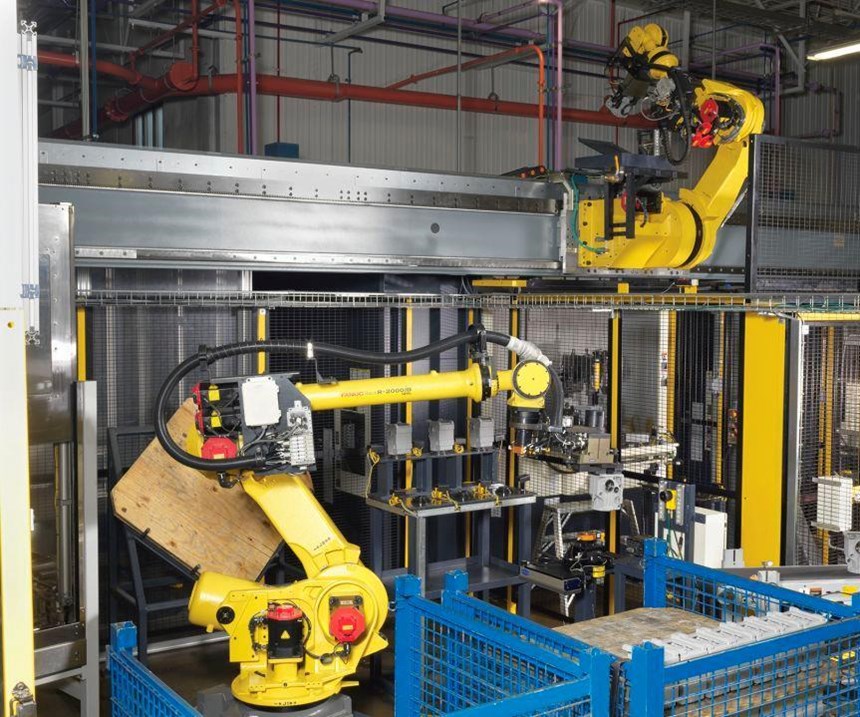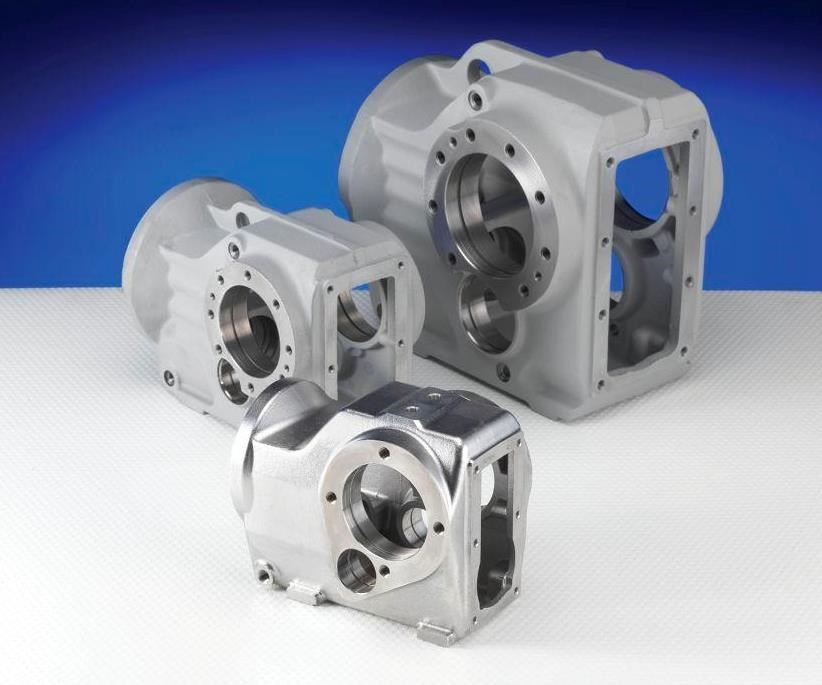Automation Increases Production, Employee Retention
Employee fatigue at SEW Eurodrive was limiting productivity when production demands increased. Automation from Makino helped to increase machine utilization as well as worker satisfaction.
Share




While sometimes a controversial move for manufacturers, SEW Eurodrive of Lyman, South Carolina, knew it needed to implement automation to combat an increase in minor health and safety issues as well as extended, seven-day workweeks. The company wanted to provide a safe and appreciative work environment, and Chuck Chandler, assistant plant manager, says automation from Makino (Mason, Ohio) helped SEW reach those goals. In fact, the average employee has now been part of the company for 19 years. Along with boosting employee retention, he says that automation has helped SEW to continuously challenge its team while providing them with the flexibility necessary to develop creative manufacturing solutions.
SEW’s journey into automation began in 1999, when it began to evaluate solutions for transferring exhaustive work and extended hours from the workers to the machines. Initial discussions were met with some hesitancy among staff due to fear of job loss. To quash those concerns, management promised that any current jobs would not be lost as a direct result of automation. Managers knew that upholding this agreement was essential to long-term success and retaining the expertise that they had nurtured over the years.
The company’s initial automation investments started off simple with linear pallet systems, which helped increase machine utilization and enabled the company to familiarize itself with the methods and processes of automation. However, these systems did not fully address issues of operator ergonomics.
Several years later, SEW invested in its first fully automated robot-tended system from a reputable machine supplier that used a third-party integrator. “The overall experience of working with robotics was very positive and substantiated our team’s belief that this was the right direction to go; however, it also raised concerns about our selection of suppliers,” Mr. Chandler says. “Not only did cell installation take more than twice as long as the supplier initially quoted, but almost every issue that arose during the process resulted in arguments between the two companies. We came away from the experience with some degree of confidence in the technology, but not in the people or the suppliers we worked with.”
Despite installation issues, the value of the robotic system was clear in its improvements to both efficiency and operator wellness, SEW says. In 2006, the company decided to expand its robotic system, but it was again confronted with the challenge of identifying a supplier for equipment and integration.
“The previous integrator was no longer in business, and even if it had been, we knew we needed an experienced supplier that could be trusted to uphold its promises,” Mr. Chandler says. “Our team had always thought highly of Makino for its machinery, but previously considered its equipment to be excessive for the production requirements of our gearbox housings. However, at IMTS 2006, we saw an automation setup in Makino’s booth that immediately caught our eye. We spoke with its engineers about our expansion plans and learned about its automation and engineering capabilities. We knew it had the machines for the job, but we were pleasantly surprised to learn that it could also provide tooling, fixtures, automation and engineering, all under one roof.”
In 2007, SEW hired Makino to take on the expansion of its existing eight-machine robotic cell. The upgrade consisted of four Makino a71 horizontal machining centers (HMCs), a second coordinate measuring machine (CMM), two additional pedestal robots, a second gantry robot and custom software to facilitate communications between new and existing equipment. Makino managed all aspects of the system, including third-party equipment, the human-machine interface (HMI), process engineering, tooling and fixtures. Every step of the project was led with single-point-contact project management, project engineering, on-site supervision, and post-installation training and support. Not only was Makino able to take on the expansion project, but it also made improvements to the efficiency and productivity of the original cell, SEW says. Throughout the expansion project, SEW was able to run production orders in the existing cell with only minimal interruption when the final expansion was brought online. Today, it is operating 24 hours a day, five days a week, producing 4,500 housings each week.
SEW also invested in linear pallet systems to transition the entire plant to a five-day workweek. These investments included two Makino Machining Complexes (MMC2)—one system featuring four A99E HMCs and another with six a81 HMCs.
“I think a lot of manufacturers look back to investments made in the years leading up to the recession with regret, but our investments in automation really ended up being a job saver,” Mr. Chandler says. “While shops all around us were shutting their doors and laying off their workers, we just had to cut off power to a handful of machines. I think it was during this time that our team truly started to see the benefits of our investments and trust the direction that we were heading. Had we approached our production methods similar to many other plants by putting an operator at every machine, we would have had to lay off 50 percent or more of our staff.”
As production ramped back up following the recession, SEW experienced rapid demand for a new line of gearboxes, numbering 500,000 units per year, but it needed to meet this demand while still operating five days per week and without making any new hires. The only way to achieve this was through a new automated system.
The new cell features an overhead gantry robot that services six a81 HMCs. Each machine fixture includes one location for machining a raw part and one location for machining a semi-finished part. The gantry robot shuffles parts during an unload/load sequence using a vision system that is attached to the robot carriage to generate offsets for loading parts onto the fixtures.
In order to keep the automated cell in operation, raw parts are continuously delivered by forklifts. The parts arrive in bins at two areas where a pedestal robot uses a vision system to locate and pick parts from the bins. The raw parts are presented to a separate vision system to verify that they are of the correct type before they are placed on a dedicated raw-part stand for the gantry robot to access. The gantry robot transports finished parts from each machine and places them on a dedicated finished part stand for access by the pedestal robot. The pedestal robot presents the parts to a marking system where they receive a 2D matrix code. Next, the robot moves the parts to a vision system that verifies the matrix code.
In the next stage, finished parts are transferred into a booth containing a smaller pedestal robot. There, the parts are air-blasted to remove residual liquid and debris. Once cleaned, the robot transfers each part to a CMM, where it is inspected and verified before being delivered to the finished part bin. Forklifts then remove the full finished part bins from the cell to be prepped for delivery.
The cell is managed by two HMIs, which were designed with custom control screens that enable operators to quickly and easily select part types, enable/disable functions, select inspection frequency and type, and view current system information status appropriate for the application. Additionally, the control interfaces provide warnings and information regarding system alarms along with guidance about how to how to resolve the issue.
SEW’s system was designed to run two different part numbers at high volumes while providing flexibility within the programming to accommodate six other part types. Several of the robots execute tasks within common areas, so complex system coordination is handled by the cell’s controls.
Installation of the system was completed within projected timelines, and SEW’s cell operated at peak performance on its first production run, the company says.
“We trust the reliability of Makino’s machines and the processes that their engineers create,” says Melvin Story, manufacturing engineering technician. “Part quality is non-negotiable for us, so repeatability and accuracy are essential. The a81 machines consistently meet our 13-micron bore tolerances and maintain repeatability within 20 to 30 microns on location tolerances. As a result, our scrap rate is less than 1 percent every year, and that includes any casting flaws.”
Operators attended training at Makino’s headquarters to help them understand the cell controllers and enable them to manage systems efficiently with a high-degree of confidence. “When developing the HMI, our team strives for simplicity through standardization of menus and messaging that makes it easy for operators to quickly identify and resolve issues. It is all about balancing aesthetics and functionality for optimum performance,” says Paul Woodbury, project engineering team leader at Makino.
Through its more than a decade-long experience with complex automation systems, SEW’s Lyman plant production output has grown tenfold with only a 6 percent increase in manpower since the installation of the first automated cell. This has not only helped the plant to retain skilled labor during tough economic cycles, but it has also led to improved product costs and the potential for greater profitability for years to come.
Related Content
Manufacturing Madness: Colleges Vie for Machining Title (Includes Video)
The first annual SEC Machining Competition highlighted students studying for careers in machining, as well as the need to rebuild a domestic manufacturing workforce.
Read MoreCan Connecting ERP to Machine Tool Monitoring Address the Workforce Challenge?
It can if RFID tags are added. Here is how this startup sees a local Internet of Things aiding CNC machine shops.
Read MoreWorkholding Fixtures Save Over 4,500 Hours of Labor Annually
All World Machinery Supply designs each fixture to minimize the number of operations, resulting in reduced handling and idle spindle time.
Read MoreHow I Made It: Amy Skrzypczak, CNC Machinist, Westminster Tool
At just 28 years old, Amy Skrzypczak is already logging her ninth year as a CNC machinist. While during high school Skrzypczak may not have guessed that she’d soon be running an electrical discharge machining (EDM) department, after attending her local community college she found a home among the “misfits” at Westminster Tool. Today, she oversees the company’s wire EDM operations and feels grateful to have avoided more well-worn career paths.
Read MoreRead Next
Registration Now Open for the Precision Machining Technology Show (PMTS) 2025
The precision machining industry’s premier event returns to Cleveland, OH, April 1-3.
Read MoreSetting Up the Building Blocks for a Digital Factory
Woodward Inc. spent over a year developing an API to connect machines to its digital factory. Caron Engineering’s MiConnect has cut most of this process while also granting the shop greater access to machine information.
Read More5 Rules of Thumb for Buying CNC Machine Tools
Use these tips to carefully plan your machine tool purchases and to avoid regretting your decision later.
Read More


























.jpg;maxWidth=300;quality=90)















